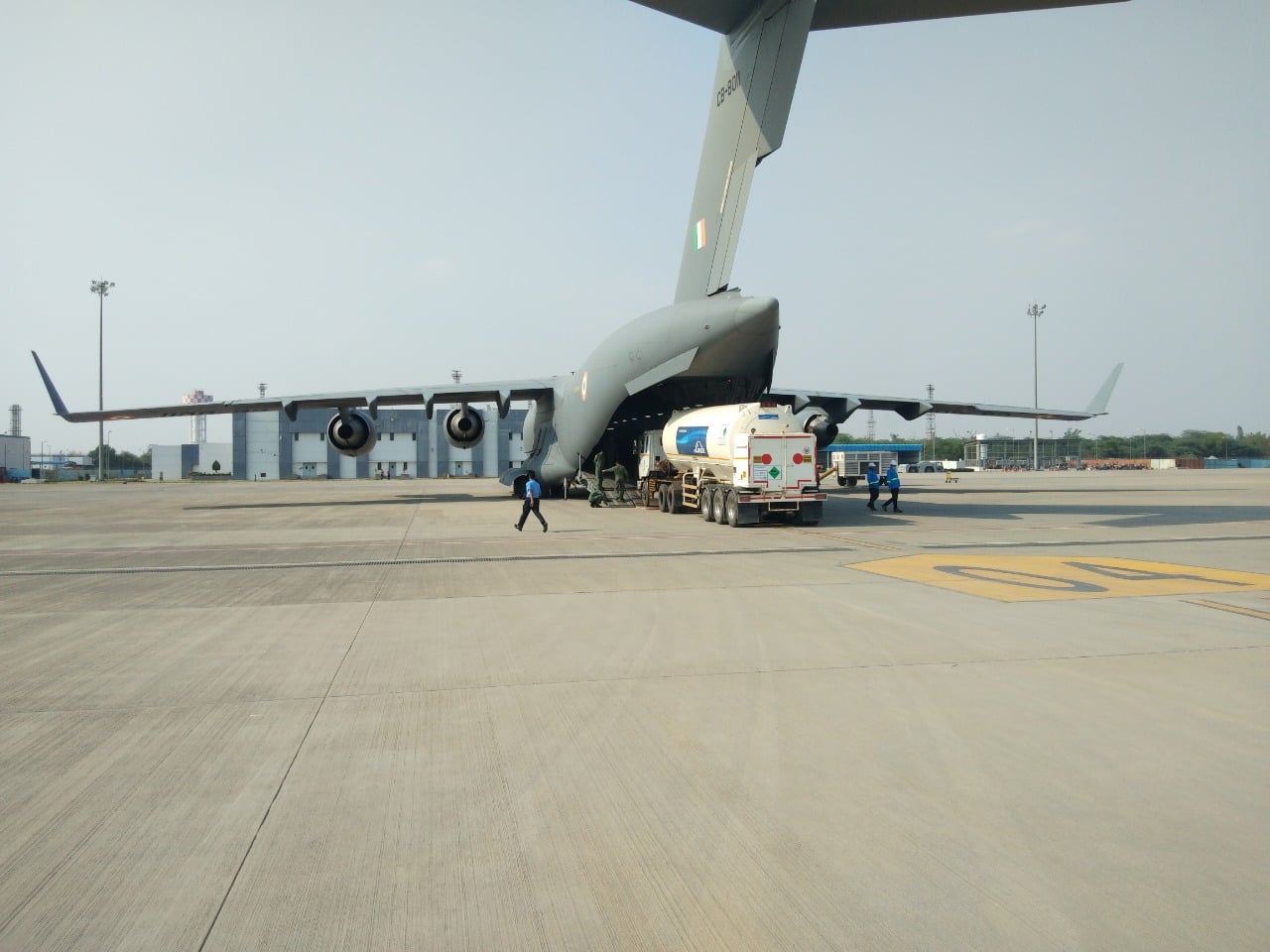Aviation
Acquired from scrap, restored Dakota to join IAF fleet in March

- Douglas DC3 aircraft, better known as the Dakota, carried the troops of the Army’s 1 Sikh Regiment to Srinagar on Oct 27, 1947, during the 1st Indo-Pak War.
- The Dakota will bear the tail number VP 905, the same as the 1st such aircraft in the Indian service that transported the troops during the 1947 war to J&K.
New Delhi, 13 February 2018: In a Historic moment for the nation and the Indian Air Force, Rajya Sabha MP Rajeev Chandrasekhar today gifted a DC3 Dakota aircraft bearing the Tail Number VP 905 and called “Parashurama” in a signing ceremony to The Indian Air Force to be part of its Vintage Fleet.
The Gift Deed was signed between Air Chief Marshal Birender Singh Dhanoa, PVSM, AVSM, YSM, VM, ADC , Chief of the Air Staff of the Indian Air Force and Air Commodore M K Chandrasekhar, VM, VSM (Retd)- Rajeev Chandrasekhar’s father who an Dakota Pilot himself.
The MP gifted the restored WW2 Dakota aircraft’s Papers & Deed to Chief of Air Staff on behalf of his father.
This Tail No. VP -905 is the same as the first Dakota aircraft that transported troops of 1 Sikh regiment to Srinagar on 27 October 1947 in the J&K operations.
The Tail No. VP 905 – this holds special significance for the Dakota and the Indian Air Force.
On 27 October 1947, three Dakotas of No. 12 Sqn took off from Wellingdon airfield (Safdarjung) at 0500 hours for Srinagar signalling the start of the IAF operations in the 1947-48 Indo Pak War. Before the end of the day, 28 Dakota sorties were flown (including 6 civilian sorties.)
The first Dakota Aircraft to take off and land at Srinagar piloted by Wing Commander K L Bhatia and carrying the first batch of troops of 1 Sikh Regiment under command of Lt Col Dewan Ranjit Rai bore the Tail No VP 905.
Speaking on the Occasion, MP Rajeev Chandrasekhar said “The Dakota (Dak) was also part of my childhood as my father flew it all over India and so today I fulfil my dream of helping my father donate a DC3 Dakota to the Indian Air Force”
“This aircraft VP 905 is dedicated to all Air Warriors and their families who served an flew the Dakota in various IAF operations in remotest parts of #India from 1947-1971” an emotional Air Commodore M K Chandrasekhar, VM, VSM (Retd) said.
“On being asked on why he chose the Aircraft to be named “Parashurama” the MP said “The Dakota DC3 was named Parashurama – to signify the eternal warrior – after Saint Parashurama – the sixth avatar of Vishnu. Like other avatars of Vishnu, he appears at a time when overwhelming evil prevailed on earth to correct the cosmic equilibrium by destroying the evil forces.”

Aviation
Exploring the Different Types of Helicopter Rotor Systems and the Science Behind Them

Helicopters are unique aircraft that use rotating blades, called rotors, to generate lift and enable flight. The design of these rotor systems is crucial because it affects how helicopters perform, maneuver, and respond to different flying conditions.
There are several types of helicopter rotor systems, each with its own advantages and specific uses. Understanding these systems helps us appreciate the engineering behind helicopters and their diverse capabilities, from search and rescue missions to military operations and aerial photography.
In this Video, we will explore the main types of helicopter rotor systems and how they contribute to the helicopter’s functionality and performance.
1. Single Rotor System
The single rotor system is characterized by a single main rotor blade that is responsible for generating lift. To counteract the torque produced by this rotor, a tail rotor is used. This setup is essential for maintaining directional control and stability during flight.
Uses: This design is prevalent in most conventional helicopters, including iconic models such as the Bell 206 and the Robinson R22. The simplicity of the single rotor system not only reduces mechanical complexity but also enhances efficiency. As a result, it is favored for a variety of applications, including aerial tours, law enforcement, and emergency medical services, where reliability and straightforward operation are paramount.
2. Tandem Rotor System
The tandem rotor system features two parallel rotors of equal size that rotate in opposite directions. This counter-rotation helps to cancel out the torque that each rotor would otherwise produce, resulting in a balanced and stable flight profile.
Uses: This configuration is typically employed in heavy-lift helicopters, such as the CH-47 Chinook. The tandem design allows for an increased payload capacity and enhanced stability, making it particularly effective for transporting troops, equipment, and supplies in military operations, as well as for civilian applications like logging and construction, where heavy lifting is required.
3. Coaxial Rotor System
The coaxial rotor system consists of two rotors mounted one above the other on the same mast, rotating in opposite directions. This innovative design minimizes the need for a tail rotor, allowing for a more compact helicopter structure.
Uses: Coaxial rotor systems can be found in helicopters such as the Kamov Ka-50. This design offers several advantages, including enhanced lift capabilities, improved maneuverability, and better control in various flight conditions. These features make it particularly suitable for military applications, where agility and quick response times are crucial, as well as for specific civilian operations that require high performance in tight spaces.
4. Intermeshing Rotor System
The intermeshing rotor system consists of two rotors that rotate in opposite directions while intersecting each other, but without colliding. This unique configuration creates a highly efficient aerodynamic profile.
Uses: This system is utilized in helicopters like the Kaman K-MAX, designed specifically for heavy lifting and aerial work. The intermeshing rotors provide remarkable stability and lift capabilities, making it particularly effective for operations in confined spaces, such as urban environments or dense forests. It is ideal for missions that involve heavy external loads, including construction, firefighting, and disaster relief efforts.
5. Transverse rotor system
The transverse rotor system has two parallel rotors that spin in opposite directions, improving lift and stability. This design enhances the aircraft’s aerodynamic efficiency and maneuverability.
A notable example of this system is the V-22 Osprey, a tiltrotor aircraft that merges helicopter vertical lift with the speed of a fixed-wing plane. allowing the Osprey to operate in tough environments like urban areas and remote locations. It can carry heavy loads and personnel, making it suitable for troop transport, search and rescue, medical evacuation, and logistical support in military operations. Overall, the transverse rotor system enhances the V-22 Osprey’s effectiveness and operational flexibility.
6. Compound Rotor System
The compound rotor system combines traditional rotor systems with fixed wings and other aerodynamic features to enhance efficiency and speed. This hybrid approach allows for greater aerodynamic performance than standard rotorcraft.
Uses: Advanced helicopters like the Sikorsky X2 and Boeing’s DBF (Defiant) utilize the compound rotor system. These helicopters are designed for higher speeds and longer ranges, making them suitable for military operations, search-and-rescue missions, and law enforcement tasks where rapid response and extended operational capabilities are essential.
7. NOTAR system
NOTAR system replaces the traditional tail rotor with a ducted fan and directional airflow to counter the torque from the main rotor. It works by pushing air through the tail boom and out through side vents, creating thrust that stabilizes the helicopter. This design reduces noise, boosts safety, and cuts down on maintenance.
Uses: The NOTAR system is found in helicopters like the MD 520N and MD 902 Explorer. Without an exposed tail rotor, it lowers the risk of rotor strikes, making it safer for operations in tight spaces. Its quieter performance is ideal for missions where low noise is needed, such as urban air operations, police work, and medical evacuations.
-

 Aviation2 months ago
Aviation2 months agoNew EU Carry-On Rules Begin September 2024: What to Expect
-

 Aviation2 months ago
Aviation2 months agoBoeing confirms 797: A New Era for Mid-Size Aircraft
-

 Aviation2 months ago
Aviation2 months agoLockheed and Tata Team Up to Build C-130J MRO Facility in India
-

 Aviation1 month ago
Aviation1 month agoMicrosoft Flight Simulator Raises $3 Million to Bring Back the An-225 Mriya
-

 Tech2 months ago
Tech2 months agoChina Developing Jet to Travel Anywhere in Two Hours
-

 Airlines2 months ago
Airlines2 months agoQantas Engineers Stage Walkout Over Cost of Living Concerns
-

 Aviation2 months ago
Aviation2 months agoBoeing Offers 25% Pay Increase & Promise to Build Next Plane in Seattle
-

 Airlines1 month ago
Airlines1 month agoQatar Citizens Can Travel to the United States Without a Visa








